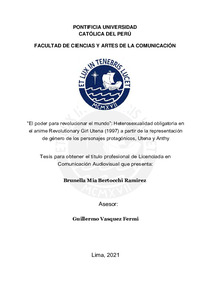| dc.contributor.advisor | Vasquez Fermi, Guillermo | |
| dc.contributor.author | Bertocchi Ramirez, Brunella Mia | |
| dc.date.accessioned | 2022-01-31T14:26:29Z | |
| dc.date.available | 2022-01-31T14:26:29Z | |
| dc.date.created | 2021 | |
| dc.date.issued | 2022-01-31 | |
| dc.identifier.uri | http://hdl.handle.net/20.500.12404/21471 | |
| dc.description.abstract | La presente investigación pretende analizar la manifestación de la heterosexualidad obligatoria
en el anime Revolutionary Girl Utena (1997) a través de sus dos personajes protagónicos,
Utena y Anthy, a lo largo del relato. Para esto, se utilizaron los mandatos de heterosexualidad
obligatoria presentados por Adrianne Rich, y se plantearon tres reacciones a estos: la adhesión,
oposición y neutralidad. Como complemento, se identificaron una serie de características que
suelen ser asociadas a comportamientos masculinos o femeninos en productos audiovisuales,
a partir de investigaciones desarrolladas por Therese Ottosson y Xin Cheng, y por Dawn
Elizabeth England, Lara Descartes y Melissa A. Collier-Meek. Estas variables fueron aplicadas
a los personajes de Utena y Anthy, escogiendo los ocho episodios que mejor ejemplifican su
evolución durante el relato. En función al análisis, se concluye que la heterosexualidad
obligatoria es manifestada como la mayor fuerza antagónica para los personajes protagónicos,
Utena y Anthy. Además, dichas manifestaciones aparecen dentro del marco de las
convenciones y reglas establecidas en tres categorías de anime dedicadas a personajes
femeninos y/o relaciones lésbicas (el shojo, yuri y Class-S). Si bien estas existen dentro de lo
tradicional, serán re-configuradas y subvertidas en el relato de RGU. A partir de esto, la
heterosexualidad obligatoria será representada a través de distintos elementos visuales y
narrativos, a los que Utena y Anthy se opondrán gradualmente movilizando una serie de
cambios en la representación de género de dichos personajes a lo largo del relato y enfatizando
en la posibilidad revolucionaria del amor lésbico. Por lo tanto, no se encontrará una
representación de género estandarizada, sino una que se construye personalmente, y es honesta
para ambos personajes según sus similitudes y diferencias. | es_ES |
| dc.description.abstract | This research aims to analyze the manifestation of compulsory heterosexuality in the anime
Revolutionary Girl Utena (1997) through its two main characters, Utena and Anthy. For this,
Adrienne Rich’s compulsory heterosexuality mandates were used, proposing three reactions to
them: adherence, opposition and neutrality. As support, a series of features usually associated
with masculine or feminine behaviors on audiovisual products were identified, using the
investigations from Therese Ottosson and Xin Cheng, and from Dawn Elizabeth England, Lara
Descartes y Melissa A. Collier-Meek. Then, these variables were applied to the characters of
Utena and Anthy, picking the eight episodes that best exemplify their evolution through the
story. Based on the analysis, it’s concluded that compulsory heterosexuality manifests as the
biggest antagonistic power for the main characters, Utena and Anthy. Furthermore, these
manifestations appear in the frame of conventions and rules established in three anime
categories dedicated to female characters and/or lesbian relationships (shojo, yuri and Class-
S). Even though these three exist within the traditional, they will be re-configured and subverted
in RGU’s story. From this, compulsory heterosexuality will be represented through different
visual and narrative elements which Utena and Anthy will gradually oppose, mobilizing a
series of changes in the gender representation of said characters through the story and
emphasizing the revolutionary possibility of lesbian love. Therefore, a standardized gender
representation won’t be found but rather one that is constructed personally, and is honest for
both characters based on their similarities and differences. | es_ES |
| dc.language.iso | spa | es_ES |
| dc.publisher | Pontificia Universidad Católica del Perú | es_ES |
| dc.rights | info:eu-repo/semantics/openAccess | es_ES |
| dc.rights.uri | http://creativecommons.org/licenses/by-nc/2.5/pe/ | * |
| dc.subject | Género | es_ES |
| dc.subject | Lesbianismo | es_ES |
| dc.subject | Homosexualidad | es_ES |
| dc.subject | Tiras cómicas, historietas, etc. | es_ES |
| dc.title | El poder para revolucionar el mundo: Heterosexualidad obligatoria en el anime Revolutionary Girl Utena (1997) a partir de la representación de género de los personajes protagónicos, Utena y Anthy | es_ES |
| dc.type | info:eu-repo/semantics/bachelorThesis | es_ES |
| thesis.degree.name | Licenciado en Comunicación Audiovisual | es_ES |
| thesis.degree.level | Título Profesional | es_ES |
| thesis.degree.grantor | Pontificia Universidad Católica del Perú. Facultad de Ciencias y Artes de la Comunicación. | es_ES |
| thesis.degree.discipline | Comunicación Audiovisual | es_ES |
| renati.advisor.dni | 07881979 | |
| renati.advisor.orcid | https://orcid.org/0000-0001-6115-3172 | es_ES |
| renati.author.dni | 76217791 | |
| renati.discipline | 211086 | es_ES |
| renati.juror | Del Aguila Lao, Silvia Dorothy | es_ES |
| renati.juror | Oliart Velarde, Rosa Maria | es_ES |
| renati.juror | Vasquez Fermi, Guillermo | es_ES |
| renati.level | https://purl.org/pe-repo/renati/level#tituloProfesional | es_ES |
| renati.type | https://purl.org/pe-repo/renati/type#tesis | es_ES |
| dc.publisher.country | PE | es_ES |
| dc.subject.ocde | https://purl.org/pe-repo/ocde/ford#5.08.00 | es_ES |






